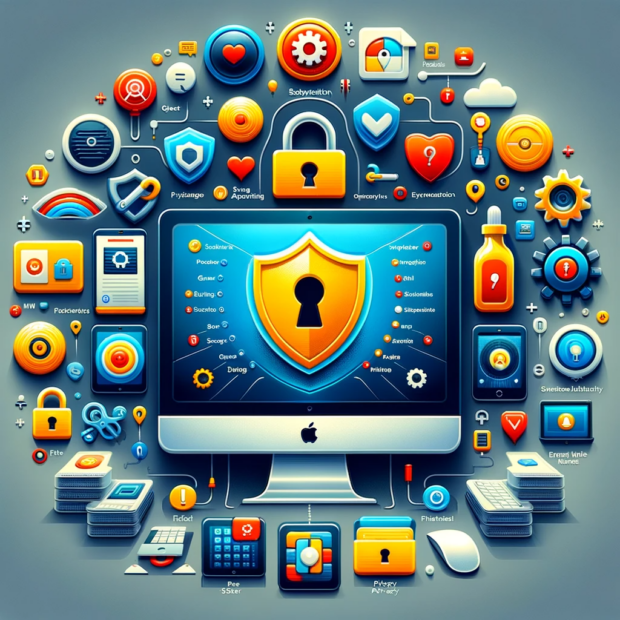In the current digital era, the security of your Mac is paramount. While Macs are often praised for their robust security features, they are not impervious to threats. This guide is designed to walk you through the essential steps to bolster your Mac’s security and privacy, ensuring you stay protected in an ever-evolving cybersecurity landscape.
Interesting articles:
- Safari Privacy Settings: Enhancing Your Online Security on Mac
- How to Log Out of a Mac: A Complete Guide
Enable FileVault for Full-Disk Encryption
Your journey to a secure Mac should begin with FileVault, Apple’s full-disk encryption tool. It encrypts the entire system drive, making your data inaccessible to unauthorized users.
- Open “System Preferences” and click on “Security & Privacy.”
- Select the “FileVault” tab.
- Click on “Turn On FileVault” and follow the prompts to start the encryption process.
Once enabled, FileVault ensures that your files are secure, even if your Mac falls into the wrong hands.
Update Your Operating System and Apps Regularly
Keeping your macOS and applications up-to-date is crucial. Regular updates not only bring new features but also patch known security vulnerabilities.
- Open “System Preferences” and choose “Software Update.”
- Enable the option for automatic updates.
This ensures that your Mac always runs the latest software, reducing the risk of exploitation through outdated software vulnerabilities.
Set Up Strong Passwords and Enable Two-Factor Authentication
Strong passwords and Two-Factor Authentication (2FA) are fundamental to securing your accounts.
- Use complex passwords for your device and online accounts.
- Enable 2FA for your Apple ID via the Apple ID settings. This adds an additional layer of security, requiring a second form of authentication beyond just your password.

Adjust Your Firewall Settings
The firewall on your Mac monitors and controls incoming and outgoing network traffic based on predetermined security rules.
- Go to “System Preferences,” then “Security & Privacy.”
- Navigate to the “Firewall” tab and click “Turn On Firewall.”
A properly configured firewall acts as a barrier against unauthorized access to your Mac while allowing legitimate communication to pass through.
Implement Privacy Controls
To manage how apps access your personal data:
- In “Security & Privacy,” click the “Privacy” tab.
- Review the list of apps and their access to services like Location Services, Contacts, Calendars, etc.
- Uncheck any apps that you do not want to have access to your information.
This step ensures that only trusted applications have access to your sensitive data.
Use Guest Accounts for Temporary Users
For users who need temporary access to your Mac, a Guest account is a secure option.
- In “System Preferences,” select “Users & Groups.”
- Click on the lock icon and enter your password.
- Select “Guest User” and ensure it is enabled.
Guest accounts provide limited access, safeguarding your personal files and settings.
Practice Safe Browsing and Beware of Phishing Scams
Staying safe online is more important than ever.
- In Safari, use private browsing to prevent storing browsing history.
- Be cautious with emails and messages from unknown sources. Phishing scams often impersonate legitimate sources to steal information.
Backup Your Data with Time Machine
Regular backups protect against data loss.
- Connect an external drive to your Mac.
- In “System Preferences,” select “Time Machine.”
- Click “Select Backup Disk” and choose your external drive.
With Time Machine, your data is regularly backed up, providing peace of mind.
Secure Sensitive Files with Disk Utility
Disk Utility can create encrypted storage containers for your sensitive files.
- Open “Disk Utility” from the Applications folder.
- Click “File,” then “New Image,” and select “Image from Folder.”
- Choose the folder you want to encrypt and set a password.
Consider Additional Security Measures
For heightened security:
- Use physical security keys or authenticator apps for stronger 2FA.
- Enable Lockdown Mode on iOS 16 for protection against sophisticated cyber-attacks.
Regularly Audit Your Mac for Unused Apps and Features
Keeping your Mac streamlined and updated minimizes security risks.
- Periodically review and delete unused apps.
- Disable features like Remote Access, Bluetooth, and Siri when not in use.
Conclusion
Securing your Mac is a continuous process, requiring vigilance and regular updates. By following these steps, you significantly enhance your Mac’s security and privacy. Stay informed and proactive to protect your digital life.
